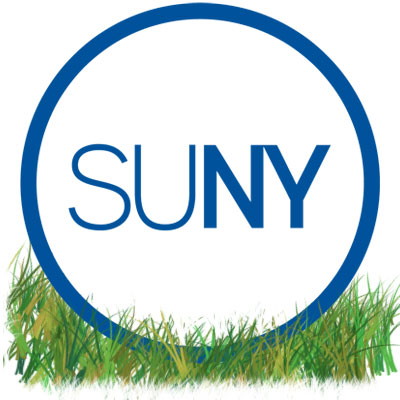 SUNY as a system maximizes the Energy Smart New York campaign every single day of the year; after all, 97% of the state’s population is within 20 miles of a SUNY campus. As an economic driver in New York State, SUNY capitalizes on the opportunity to profoundly affect New Yorkers by instating smart, and sometimes bold, environmental goals.
SUNY as a system maximizes the Energy Smart New York campaign every single day of the year; after all, 97% of the state’s population is within 20 miles of a SUNY campus. As an economic driver in New York State, SUNY capitalizes on the opportunity to profoundly affect New Yorkers by instating smart, and sometimes bold, environmental goals.
Today we focus on a recent national intercampus achievement and groundbreaking systemwide initiative that both focus on the environment. And to kick off our highlighting of SUNY’s eco-friendly push, our Generation SUNY team spoke to SUNY ESF faculty expert Dr. Elizabeth Folta on how SUNY students can maximize (or minimize!) their impact throughout the year with our brand-new video series, Interview With A. Check it out after the jump!
[iframe width=”728″ height=”410″ src=”http://www.youtube.com/embed/Dfk1pdNxBVM” frameborder=”0″ allowfullscreen]
64 SUNY Campuses: National “Green” Leaders
Contributing to SUNY’s systemness and acting for the best interest of their communities, each of our 64 campuses plays a vital role in environmental awareness and impact.
Just last week, eight SUNY campuses were named among 230 colleges by The Princeton Review, in collaboration with the Center for Green Schools at the U.S. Green Building Council (USGBC), for being the most environmentally responsible “green colleges” in the U.S. and Canada.
“SUNY’s commitment to an energy-smart New York and to sustainability throughout our system is a critical component of our strategic plan, one that our campuses have widely embraced and consistently shown leadership on,” said SUNY Chancellor Zimpher. “Congratulations to the eight SUNY campuses listed in the 2013 Guide to Green Colleges. This recognition is much deserved and highly commendable.”
The eight campuses named are among all 64 that show due diligence in their environmental efforts day after day. The highlighted campuses include SUNY Oneonta, SUNY New Paltz, SUNY Potsdam, University at Albany, Binghamton University, SUNY Geneseo, Stony Brook University, and College of Environmental Science and Forestry.
The Princeton Review notes that for students who want to be equipped to join the emerging green market, it means attending a college that offers a green education. Schools that score well on the Green Rating have courses that help students understand their way around renewable energy, organic agriculture and the tools for developing smart, efficient products. The company continues to highlight advantages, including at SUNY College of Environmental Science and Forestry (ESF):
Not only do green colleges provide great courses, they also have undergrads involved in top-notch research. Students at SUNY ESF get to participate in projects such as the development of the state’s first wood ethanol biorefinery, which produces renewable fuel and biodegradable plastics from wood
It is no surprise that SUNY is well-represented in the rankings. The largest higher education system in the nation is a model of research, health, financial, and educational progress. From UAlbany’s commitment to recycle thousands of pounds of materials to UB’s eco-smart design of its Buffalo-Niagara Medical Campus to SUNY New Paltz’s Solar Car Race Team, the Power of SUNY is felt far beyond New York.
The “Green Ratings” of colleges were determined using a measure of how environmentally friendly the institutions are on a scale of 60 to 99. The Princeton Review tallied the rating for 806 institutions based on its institutional surveys of colleges in 2011-12 concerning their environmentally related practices, policies and academic offerings.
SUNY as a System: Tobacco Free by 2014
The Board of Trustees voted last year to support a “Tobacco-Free SUNY” policy and seek New York State legislation that bans the use of tobacco on SUNY grounds and facilities. SUNY will be the largest public university system in the United States to adopt a policy of this magnitude against tobacco use.
The policy, which is aimed to be implemented by the end of this year, needs to be passed as a State law in order for it to take full effect.
The historic adoption by the Board of Trustees was the final step in the Chancellor’s Task Force for a Tobacco-Free SUNY. While the Board is looking to improve overall well-being of its students, the move is not to simply take the butts out of students’ and staffs’ mouths; it is also to grow the SUNY body image and lessen the risk of accidental fires.
“SUNY has a responsibility to promote the health of our students, faculty, staff and visitors while they are on our campuses,” said SUNY Chancellor Zimpher. “I commend the Board for making the health of these groups a priority.”
Reducing tobacco consumption on SUNY campuses also has a favorable side affect: improving environmental conditions. According to Tobacco Free California, an awareness group supported by the California Department of Public Health, cleanup costs of cigarette butts in just that state are into the millions. In addition:
- Worldwide, it is estimated that 1.69 billion pounds of cigarette butts end up as waste each year.
- It is estimated that one tree is consumed for every 300 cigarettes produced – that’s one tree for every one and a half cartons.
- Discarded cigarette butts have been linked to large wildfires, resulting in the destruction of wildlife, vegetation and property.
Chairman of the Board H. Carl McCall added, “By establishing a policy that will prohibit the use of tobacco among our 468,000 students and 88,000 employees on campuses across New York, we will have a positive impact on their health and that of our visitors.”
SUNY’s groundbreaking tobacco ban will not only benefit all New Yorkers, but extend positive value to the entire planet.



